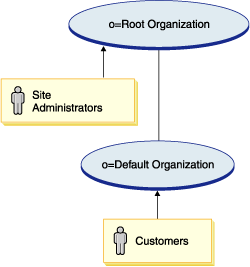Organization structure
In order to allow customers or buyers to...
- access the site
- browse the catalog
- place orders
...or to allow employees to administer the site, including...
- updating the catalog
- creating new promotions
- managing orders
or to allow resellers to...
- complete transactions on the site
...all actors in the business scenario must be assigned a position in the WebSphere Commerce organization structure.
The WebSphere Commerce organization structure provides a framework for the actors, or entities, in the business scenario. This framework is organized in a hierarchical structure, which mimics typical organizational hierarchies with entries for organizations and organizational units and users. The organizations and organizational units in the framework act as owners for the parts of the business. All parts of the business, including customers, administrators, stores, catalogs and distributors, must be owned by an organization or organizational unit.
The organization structure and the access control model, are closely related, in that the access control model applies access control policies to organizations rather than to individual entities (stores, customers, administrators and so on). The policies that apply to an entity (or resource) are applied to the organizations that own the entity or resource.
The following diagram outlines the basic WebSphere Commerce organization structure.

The basic organization structure is installed during instance creation, regardless of the business model.
- Root organization
- The root organization is the top level organization and is its own parent. All organizations in the WebSphere Commerce organization structure are descendents of the root organization. The site administrators are owned by the root organization.
- Default organization
- The default organization is owned by the root organization. All guest customers and all customers in a consumer direct scenario belong to the default organization. Customers in a B2B direct or B2B indirect scenarios can belong to either the default organization, or other organizations. Do no create stores under the default organization. Instead, create stores under a separate organization, such as the seller organization.
One or more other levels of organizational entities can exist beneath the parent organizational entities. You can add as many child organizational entities as necessary to support the business.
Sample organization structures
WebSphere Commerce provides sample organizations structures for each supported business model. These sample organization structures are available on their own (as component store archives) allowing you to use the sample organization structure as starting point for the own site, or as part of the sample businesses.
Create organization structures
Rather than create new organization structures for the site, it is recommended that you begin by publishing one of the sample organization structures provided with WebSphere Commerce, and then make changes to that organization structure as necessary.
The following table outlines the various organization structures and how they are created.
| Organization structure | Method of creation |
|---|---|
| All organization structures | Root organization and Default organization created by instance creation |
| Consumer direct organization structure |
|
| B2B direct organization structure |
|
| Demand chain organization structure |
|
| Extended sites organization structure |
|
| Supply chain organization structure |
|
The WebSphere Commerce organization structure is flexible enough to support all entities in the supported business models.
Related concepts
Consumer direct organization structure
B2B direct organization structure
Demand chain organization structure
Supply chain organization structure
Extended sites organization structure